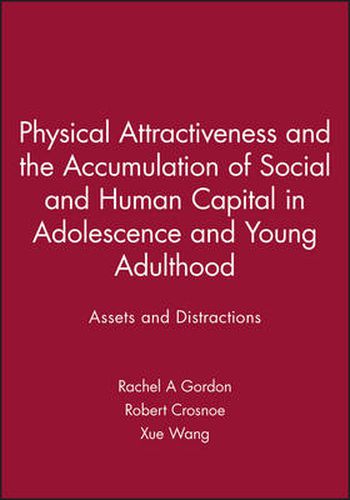Readings Newsletter
Become a Readings Member to make your shopping experience even easier.
Sign in or sign up for free!
You’re not far away from qualifying for FREE standard shipping within Australia
You’ve qualified for FREE standard shipping within Australia
The cart is loading…






Beauty has a well-documented impact on labor market outcomes with both legal and policy implications. This monograph investigated whether this stratification is rooted in earlier developmental experiences. Specifically, we explored how high schools’ dual roles as contexts of social relations and academic progress contributed to the long-term socioeconomic advantages of being physically attractive. Integrating theories from multiple disciplines, the conceptual model of this study contends that physically attractive youths’ greater social integration and lesser social stigma help them accumulate psychosocial resources that support their academic achievement while also selecting them into social activities that distract from good grades. A mixed-methods design, combining statistical analyses of the National Longitudinal Survey of Adolescent Health and qualitative analyses of a single high school, supported and expanded this model. The data revealed that the benefits of attractiveness flowed through greater social integration but were partially offset by social distractions, especially romantic/sexual partnerships and alcohol-related problems. Interview and ethnographic data further revealed that adolescents themselves understood how physical attractiveness could lead to favorable treatment by teachers and classmates while also enticing youth to emphasize socializing and dating, even when the latter took time from other activities (like studying) and marginalized some classmates. These patterns, in turn, predicted education, work, family, and mental health trajectories in young adulthood. The results of this interdisciplinary, theoretically grounded, mixed methods study suggest that adolescence may be a critical period in stratification by physical appearance and that the underlying developmental phenomena during this period are complex and often internally contradictory. The monograph concludes with discussion of theoretical and policy implications and recommendations for future developmental research.
$9.00 standard shipping within Australia
FREE standard shipping within Australia for orders over $100.00
Express & International shipping calculated at checkout
Beauty has a well-documented impact on labor market outcomes with both legal and policy implications. This monograph investigated whether this stratification is rooted in earlier developmental experiences. Specifically, we explored how high schools’ dual roles as contexts of social relations and academic progress contributed to the long-term socioeconomic advantages of being physically attractive. Integrating theories from multiple disciplines, the conceptual model of this study contends that physically attractive youths’ greater social integration and lesser social stigma help them accumulate psychosocial resources that support their academic achievement while also selecting them into social activities that distract from good grades. A mixed-methods design, combining statistical analyses of the National Longitudinal Survey of Adolescent Health and qualitative analyses of a single high school, supported and expanded this model. The data revealed that the benefits of attractiveness flowed through greater social integration but were partially offset by social distractions, especially romantic/sexual partnerships and alcohol-related problems. Interview and ethnographic data further revealed that adolescents themselves understood how physical attractiveness could lead to favorable treatment by teachers and classmates while also enticing youth to emphasize socializing and dating, even when the latter took time from other activities (like studying) and marginalized some classmates. These patterns, in turn, predicted education, work, family, and mental health trajectories in young adulthood. The results of this interdisciplinary, theoretically grounded, mixed methods study suggest that adolescence may be a critical period in stratification by physical appearance and that the underlying developmental phenomena during this period are complex and often internally contradictory. The monograph concludes with discussion of theoretical and policy implications and recommendations for future developmental research.